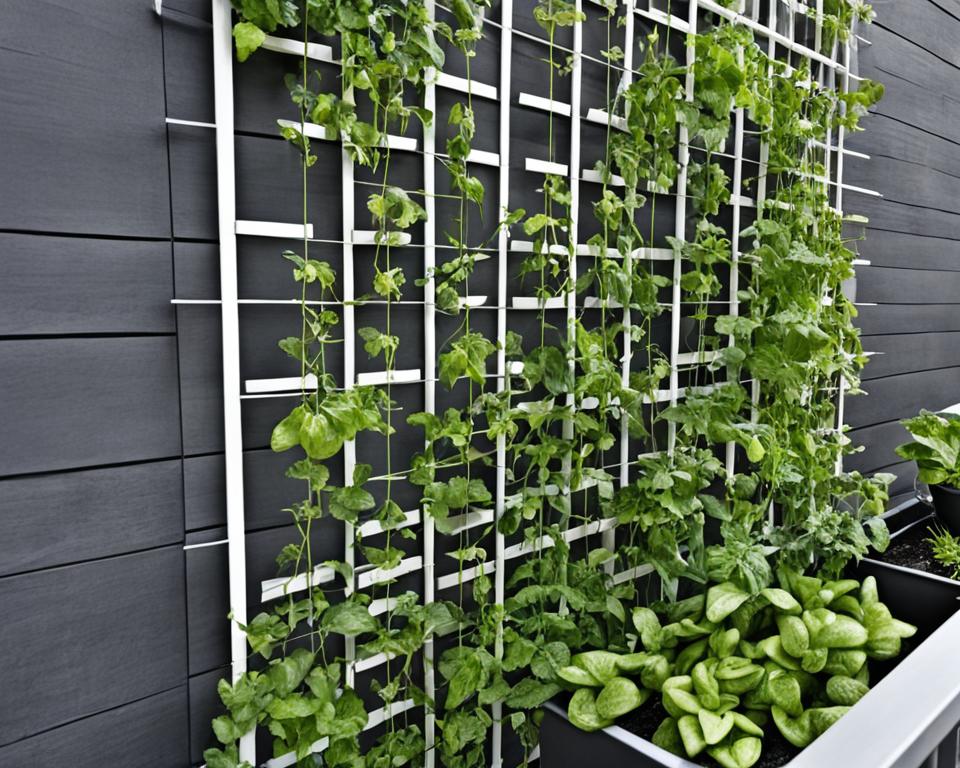Have you ever felt constrained by the limited room in your urban backyard or balcony but yearn to cultivate a lush garden? Vertical trellis gardening is the ingenious solution to your small space woes. This innovative approach harnesses the vertical expanse, transforming your confined areas into bountiful green havens. Whether you’re aiming to produce fresh vegetables or embellish your space with climbing flora, embracing a vertical garden empowers you to grow upward, not outward.
By implementing structures such as sturdy cages, stakes, and trellises in your garden, you can train a panoply of crops to ascend. From vining vegetables like squash and tomatoes to fragrant climbers such as sweet peas and pole beans, small space gardening has never been more productive or aesthetically pleasing. Say goodbye to sprawling beds that consume precious ground area; vertical trellising ensures your plants reach for the skies, giving you back every inch of your cherished outdoor space.
Key Takeaways
- Unlock the potential of limited garden space by investing in vertical trellis gardening.
- Prevent common soil-borne diseases and deter pests through the use of elevated gardening structures.
- Choose the right trellis to complement your garden’s needs and aesthetic desires.
- Experience easier maintenance and harvesting by keeping your crops within comfortable reach.
- Enhance your garden’s air circulation, which is critical for plant health and increased yield.
- Reimagine your small-space gardening strategy to include a diverse variety of vertically growing plants.
Understanding Vertical Trellis Gardening
As urban gardens flourish and outdoor space becomes a premium, the ingenuity of vertical trellis gardening is sweeping through the horticultural world. This transformative method not only elevates the aesthetics of your garden but also promises an abundance of fresh produce from a minimized footprint. Let’s delve into the mechanics of this game-changing approach to urban agriculture, explore its benefits, and guide you through choosing the perfect trellis for your green sanctuary.
What is Vertical Trellis Gardening?
Imagine your garden thriving in layers, climbing towards the sun in a harmonious blend of function and form. That’s the essence of vertical trellis gardening. Utilizing structures such as wooden stakes, metal frames, or lattice work, this technique encourages trellis plants to ascend, claiming airspace as their new frontier of growth. The versatility of a garden trellis allows you to curate a living tapestry of produce or flowers, creating a stunning focal point in your garden oasis.
The Advantages of Growing Upward
Embracing a vertical trellis doesn’t just save space; it redefines it. Benefits of this vertical venture include less weeding, since the elevated design reduces the breeding ground for weeds, and better air circulation, which is pivotal in preventing many plant diseases. Additionally, the strategic use of vertical space often means fewer pests can access your precious crops, ensuring a robust yield season after season.
Selecting the Right Trellis for Your Garden
Choosing the right trellis design is akin to picking a foundation for your home; it determines the sustainability and success of your vertical garden. It’s not one-size-fits-all; proper selection should be tailored to the trellis plants you desire to nurture. Whether you aim to support delicate morning glories or weighty watermelons, there’s a trellis to suit every gardener’s aspirations.
| Plant Type | Recommended Trellis Design | Material Suggestion |
|---|---|---|
| Lightweight Climbers (e.g., peas) | Simple netting or strings | Nylon, Plastic Mesh |
| Medium Climbers (e.g., tomatoes) | Wooden or metal stake frames | Bamboo, Steel Rods |
| Heavyweight Climbers (e.g., melons) | Sturdy lattice or A-frame structures | Cedarwood, Wrought Iron |
Garden Trellis: The Backbone of Vertical Gardening
https://www.youtube.com/watch?v=Mb2FQaQ1iLk
Vertical gardening is a trend that continues to gain popularity among urban dwellers and those with limited outdoor space. By integrating trellis gardening into your landscape, you not only optimize the available area but also set the stage for healthier plants. A trellis serves as a crucial support system for a variety of climbing plants for trellis and is an essential component for an array of vertical gardening ideas.
Your garden trellis can be as much a display of creativity as it is a functional part of your garden. Imagine the lush greenery of cucumbers spiraling up a wooden lattice, or the vibrant blooms of morning glories weaving through a metal grid. The vertical dimension adds a layer of interest and beauty to your space, making trellis gardening both a practical and aesthetic choice.
| Plant Type | Trellis Type | Benefits |
|---|---|---|
| Cucumbers | A-Frame | Provides ample space for hanging fruit, easy harvesting |
| Pole Beans | Vertical Netting | Enables beans to naturally climb, maximizing yields |
| Peas | Wire Panels | Accommodates growth without overcrowding, simplifies picking |
| Climbing Flowers (e.g., Morning Glories) | Decorative Metalwork | Adds visual appeal while supporting growth |
- The robust structure of a garden trellis can increase the lifespan of your plants by reducing their contact with damp soil, thus minimizing the risk of rot and soil-borne diseases.
- Trellises enhance air circulation through the foliage, which is pivotal in preventing the spread of mildew and pests.
- The vertical nature of these structures promotes easy access for maintenance, including pruning and harvesting — less bending and stooping for you.
Incorporating trellises is not only a solution for space constraints but also an avenue for elevating the garden experience. From aesthetic charm to the intrinsic benefits of vertical growth, trellis gardening truly is the backbone of a productive and picturesque vertical garden.
Incorporating Vertical Trellis Gardening in Small Spaces
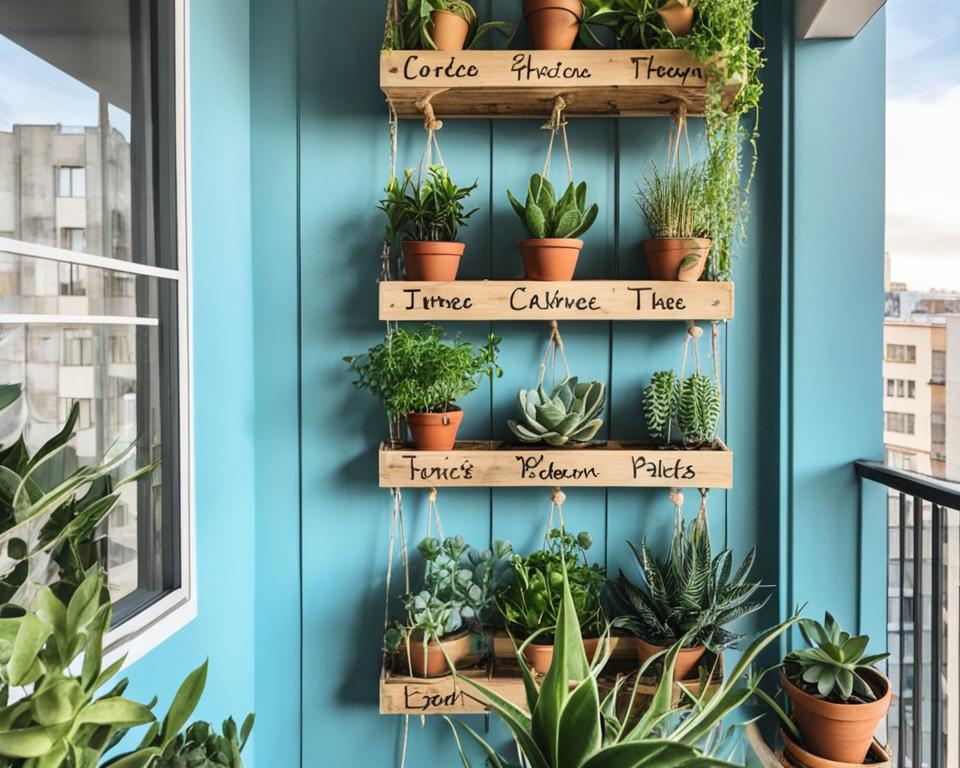
When living conditions limit your outdoor gardening space, embracing the efficiency of vertical trellis gardening opens up a new dimension of greenery. Whether you’re grappling with a modest balcony or a compact backyard, the intelligent use of a vertical trellis can transform your small space into a thriving garden.
Choosing Plants for Small Space Gardening
Choosing the right plants is essential for small space gardening. Space-savvy gardeners often opt for vining vegetables like tomatoes, cucumbers, and peas, which easily adapt to upward growth. Herbs and flowers can also flourish in a vertical setting, providing not only fresh produce but also adding a touch of beauty to your home.
DIY Trellis Ideas for Limited Spaces
For the hands-on enthusiast, DIY trellis designs are a cost-effective way to utilize every inch of your area. Simple materials like bamboo stakes, twine, and netting can be crafted into sturdy supports for your climbers. But let’s not stop there. Let’s visualize the myriad of materials you can repurpose into functional and fashionable trellises with some inspiring ideas:
- Mount a wooden lattice against the wall for a quick and elegant trellis.
- Transform an old step ladder into a charming, tiered plant stand.
- Use horizontal wires or strings across a frame to support peas and beans.
- Convert a pallet into a trellis for a rustic look.
- Create a grid with PVC pipes for a modern, minimalist vibe.
Here’s a simple guide to some vertical trellis gardening options that can suit various plants and spaces:
| Materials | Best for Plant Type | Space-Friendly Feature |
|---|---|---|
| Wooden Pallet | Herbs, Small Vining Plants | Back Against the Wall to Save Ground Area |
| Landscape Fabric | Legumes, Climbing Flowers | Lightweight and Easily Adjustable |
| Gutters | Strawberries, Succulents | Utilizes Vertical Space and Can Be Stacked |
| Bamboo Stakes | Tomatoes, Beans | Natural Look, Simple to Assemble and Disassemble |
| PVC Pipes | Cucumbers, Small Melons | Durable and Weather-Resistant |
As demonstrated, vertical trellis gardening is not only about planting; it’s about creativity, efficiency, and transforming the limited spaces into lush edible green walls or aesthetic floral displays. Take a leap into this garden trend and watch your small-space gardening flourish.
Maximizing Yield with Vertical Gardening Techniques
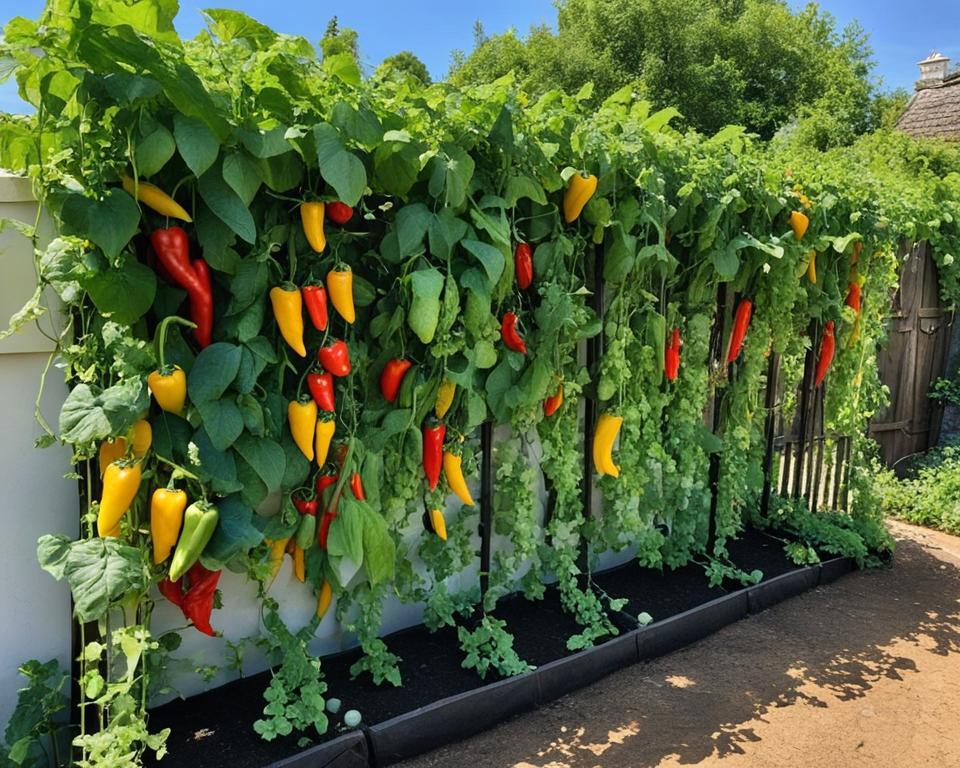
When you tackle the concept of vertical gardens, you’re not just constructing an eye-catching green display; you are also stepping up to enhance your garden’s yield and overall plant health. The secret lies within the realm of trellis gardening, a method that elevates your crops—both literally and figuratively—and introduces a spectrum of advantages for urban and space-restricted gardeners.
Increasing Airflow and Reducing Soil-borne Diseases
By implementing a garden trellis, you invite a cascade of air to whirl through the foliage and around the fruit. This is not a mere breath of fresh air for you but a gust of life for your plants. With increased airflow comes a reduction in humidity, which in turn lowers the incidence of soil-borne diseases. Trellis gardening ensures that your cucumbers, tomatoes, or squash feel the breeze as they sway gently above the ground, nestled in the sanctuary of their trellis-supported haven.
Supporting Your Plants: Training Vines for Optimal Growth
While peas and beans might eagerly twirl their tendrils around the nearest support, other vining plants such as cucumbers and tomatoes often require a guiding hand. Securing vines with ties or wire may seem like a modest task, but it’s one that embodies the art and science of trellis gardening. As you train and tether these vines to their vertical garden abode, you’re not just creating an upward path of growth; you’re engineering a lifeline of support that rewards you with bountiful harvests.
A well-structured trellis system can significantly increase the efficiency of your gardening efforts, making it a cornerstone technique for anyone wanting a lush, productive, and thoroughly vibrant vertical garden.
Climbing Plants for Trellis: Best Varieties to Choose
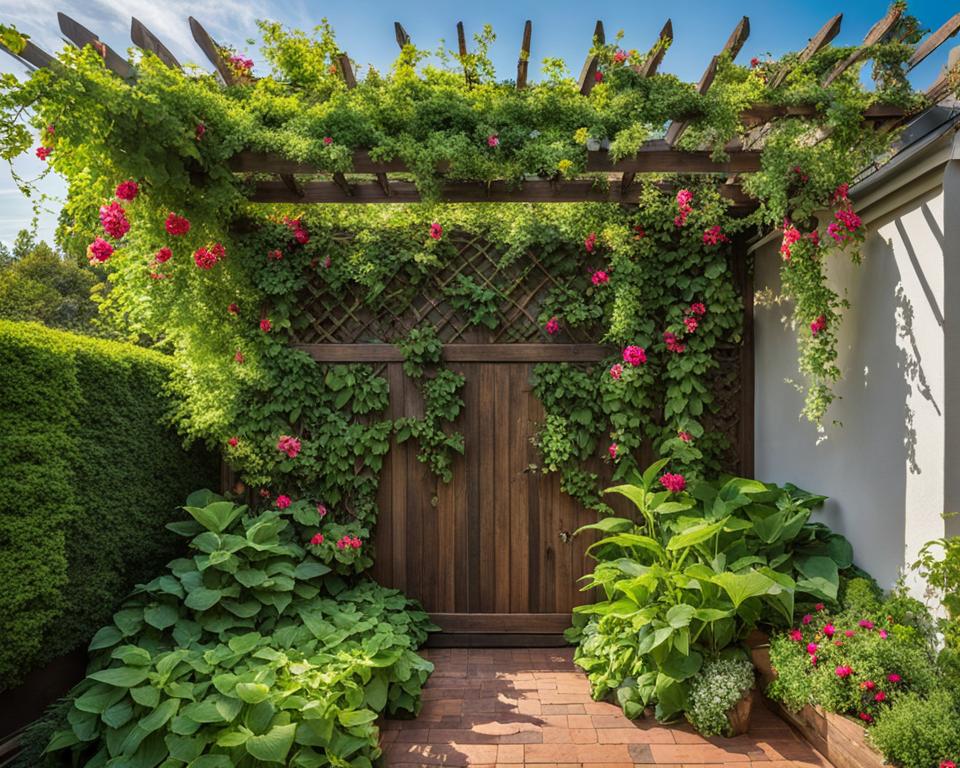
Embarking on your journey into vertical trellis gardening, it’s pivotal to select the right trellis plants. The most compatible and vibrant options are those plants with a natural propensity to ascend or trainable qualities to wrap around structures. Below you’ll find a curated list of climbing plants for trellis that will not only excel in growth but also provide aesthetic value to your garden.
Take cucumbers, for instance, which are a garden staple with their aggressive climbing tendencies. They thrive when provided with a supportive trellis. Similarly, peas will effortlessly wind their tendrils around your vertical structure, offering easy harvest and bountiful yields. Pole beans, with their twining vines, are not only practical for saving space but are also a visual treat.
| Plant Variety | Features | Support Structure |
|---|---|---|
| Cucumbers | Fast growers, heavy yielders | Strong vertical trellis |
| Peas | Natural clingers with delicate tendrils | Thin gauge supports or netting |
| Pole Beans | Twining vines that produce abundantly | Wooden stakes or wire trellises |
| Melons | Requires extra support for fruit | Heavy-duty trellis or a-frame |
| Flowing Vines (Roses, Honeysuckle, Wisteria) | Attracts pollinators, adds fragrance and color | Sturdy lattice or metal frameworks |
For those with a penchant for the whimsical, flowering vines like roses, honeysuckle, and wisteria not only engage the senses with their fragrant blooms but also invite a host of pollinators to your garden. Their need for sturdy support structures also provides you with the opportunity to integrate elegant design elements into your vertical garden layout.
When considering vertical growth, do not overlook the potential of melons and gourds—these vigorous growers will ascend trellis with zeal, though require robust support as their fruits develop. And for the more adventurous gardeners, exotic climbers like kiwi and luffa offer a unique flair and the satisfaction of a lush, productive garden canopy.
In the end, the success of these climbing wonders lies in their match with a sturdy and appropriate trellis. As you plan your vertical trellis garden, consider the individual needs of your chosen plants. With the right pairing, your upward garden will not only elevate the beauty of your outdoor space but also transform it into a high-yielding oasis.
DIY Trellis: Building Your Own Vertical Garden Structure
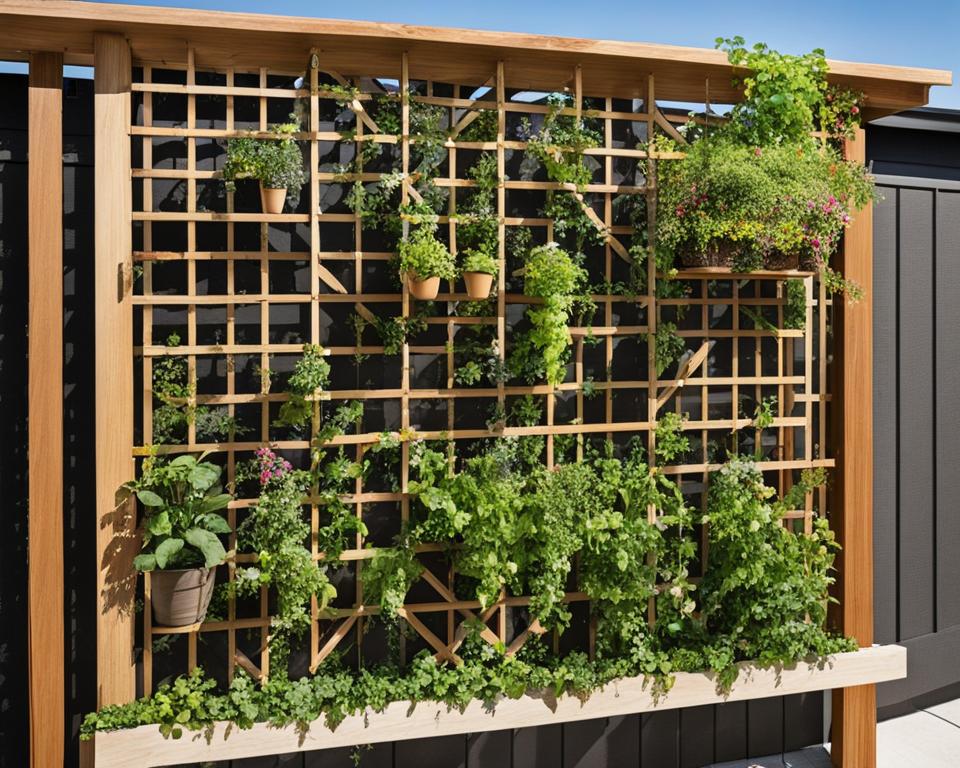
Ready to elevate your gardening game with a vertical trellis? Going the DIY route is not only cost-effective, but it also adds a personal touch to your garden. Let’s explore the essentials you’ll need to create a sturdy DIY trellis and walk through a simple guide to get you started on your vertical trellis gardening journey.
Materials You’ll Need for a DIY Trellis
Before diving into building your vertical trellis, gathering the right materials is crucial for a durable design. Here’s a list to help you get started:
- Untreated wood or metal poles – Look for those with an IPPC symbol to ensure they’re safe for garden use.
- Landscape fabric – A durable choice for supporting your plants.
- Staple gun – To secure the landscape fabric to the wooden framework.
- Nails or screws – Depending on the chosen framework material, you’ll need appropriate fasteners.
- Wire or twine – For guiding and supporting plant growth on the trellis.
Step-by-step Guide to Creating a Simple Trellis
Building your trellis is straightforward with these steps that even novice gardeners can follow.
- Measure and cut your wood or metal poles to the desired height and width for your trellis design.
- Lay out the frame on the ground and position the poles to form a grid or pattern that suits the needs of your vertical garden.
- Use your staple gun to attach landscape fabric across the framework to provide a base for your climbing plants.
- Secure joints with nails or screws to ensure your structure is robust and resilient.
- Install the trellis in your garden, anchoring it firmly into the ground or your chosen support.
- Attach wire or twine as needed to guide your plants’ growth upwards.
Remember, the key to a thriving vertical garden lies not only in the right setup but also in routine care for your trellis and the plants it supports. Happy gardening!
The Art of Vertical Trellis Gardening: Aesthetic and Functional Designs
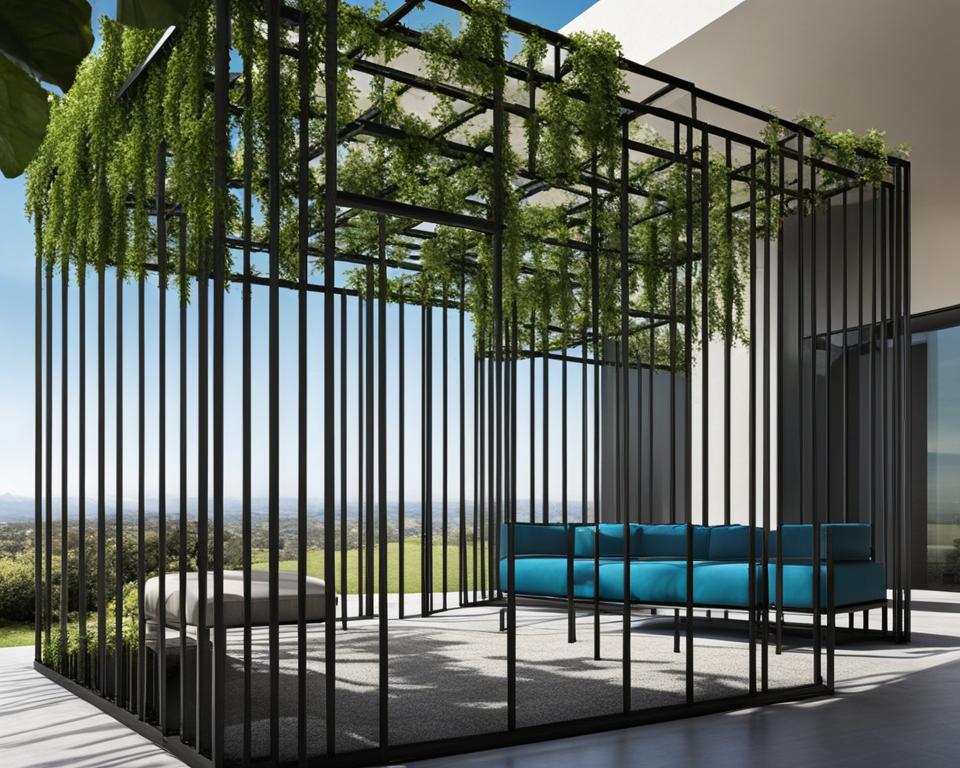
As you delve into the world of vertical trellis gardening, you come to appreciate that the structures you choose are more than just supports; they’re canvases for blending form and function. Crafting a trellis that not only secures your trellis plants but also complements your garden’s design is an art in itself. Let’s consider how to make practical use of space with trellises that double as aesthetic statements.
Trellis Design Considerations
When brainstorming vertical gardening ideas, take into account not just the type of plant you’re supporting, but also the weight it will bear throughout the growing season. The right trellis design can serve as the backbone for plants such as sweet peas, morning glories, or even watermelons, provided it’s built with resilience in mind. Moreover, the material selection – be it wood, metal, or even bamboo – should harmonize with your garden’s theme, whether rustic, modern, or eclectic.
Blending Function with Beauty in Your Garden
Gardening should be a joy, not just a task. With a trellis system, you have the opportunity to incorporate vertical gardening ideas that are as visually appealing as they are productive. Imagine a living wall of vibrant greens and florals, or a tower of tomatoes spiraling towards the sun. The goal is to create a structure that supports growth while also providing an eye-catching feature in your garden.
| Trellis Type | Best for Plants | Design Characteristics | Material Suggestions |
|---|---|---|---|
| Classic Lattice | Climbing Flowers, Ivy | Crisscross pattern, versatile | Wood, Vinyl |
| Obelisk Trellis | Roses, Clematis | Tall, pyramidal shape | Metal, Wood |
| Fan Trellis | Pole Beans, Peas | Spread out at the top for broader reach | Bamboo, Metal |
| Arched Trellis | Squash, Melons | Curved shape, sturdy for heavy fruits | Metal Rods, Reinforced Wood |
Trellis Plants: Nurturing Your Garden for Growth and Health
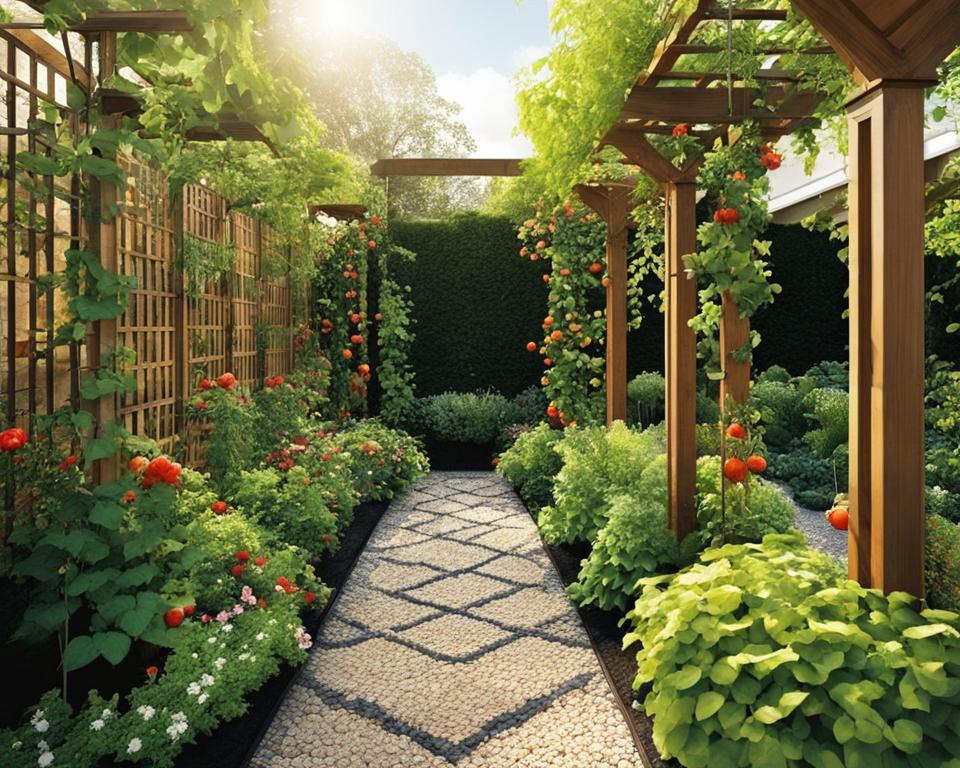
As a passionate gardener, it’s essential to focus on nurturing your trellis plants to ensure a bounty of growth and health within your vertical trellis gardening efforts. The process starts right from the selection of vines that best adapt to vertical growth, to ensuring they have the optimal conditions to thrive.
Knowing which varieties are suited to a garden trellis is just the beginning. Plants like cucumbers, peas, and beans are excellent climbers and will benefit greatly from the structure provided by a trellis. After planting, your involvement evolves into vigilant care – regular inspections, suitable training methods, and sanitation practices to prevent diseases that could hinder the growth of your garden.
One important aspect in the life of your trellis plants is the support they receive. Use ties and pruning techniques to maintain their vertical trajectory and encourage a fuller, healthier plant. Training vines not only helps with air circulation but also creates ease of access for pollinators, and eventually, for you during harvest time.
- Maintain structure sanitation
- Choose the right plants
- Proper training and pruning of vines
- Create a conducive environment for pollinators
- Regular monitoring for pests and diseases
Another step to consider is creating a nurturing base for your trellis plans. A mini-ecosystem like a lasagna garden – layering organic materials that decompose over time – can enrich the soil naturally. This method provides nourishment to your plants while encouraging beneficial microorganisms that support plant health.
By integrating these practices into your routine, you contribute not only to the visual appeal of your garden but also to the production of sustainable and organic produce. Embrace the rewards of vertical trellis gardening, for it’s a rewarding process that benefits both the gardener and the environment.
Optimizing Garden Layouts with Vertical Trellis Gardening
As a gardening enthusiast looking to embrace vertical trellis gardening, the layout of your space is a critical component that requires thoughtful planning. The secret to a successful vertical garden lies in making every inch count, ensuring plants flourish while your garden remains aesthetically pleasing and highly functional.
Planning Your Vertical Garden for Maximum Space Utilization
To make the most of your available area, assess the orientation of your garden. Determine the path of the sun across your yard to position your vertical elements in a way that gives each plant optimal light. Factor in the growth habits and mature sizes of your selected plants to avoid overcrowding and to ensure that each plant receives the attention it deserves.
Tips for Arranging Your Vertical Elements
Arranging your vertical structures strategically not only supports plant growth but can also be a unique feature of your garden’s design. Think of your garden space as a canvas where your trellises serve as both the form and function. You might consider interspersing wall planters with freestanding trellises or using DIY trellis creations as focal points that guide the eye.
Here are some suggestions for arranging your vertical gardening elements:
- Position taller trellises at the back of garden beds to allow the flow of sunlight to shorter plants in front.
- Experiment with angling trellises to create depth and dimension, as well as to capture more sunlight.
- Utilize the vertical space along fences and walls, benefiting from supportive structures and adding beauty to functional areas.
Incorporating DIY trellis ideas not only adds a personal touch to your garden but also offers a cost-effective way to support your plants. Recycled materials such as bamboo sticks, old ladders, or even intricately arranged branches can transform into beautiful vertical supports, breathing new life into your space.
Remember, the essence of vertical trellis gardening is about maximizing vertical space in a way that is practical and visually striking. With careful planning and a touch of creativity, every vertical surface is an opportunity for greenery—transforming your garden into a lush vertical oasis.
Conclusion
As we gather the strands of our exploration into vertical trellis gardening, it’s clear that the approach offers a bouquet of rewards for cultivators and connoisseurs alike. By embracing this upward-bound technique, you liberate valuable square footage while bestowing upon your plants the towering support they need to thrive. The benefits of vertical gardens bloom forth in the form of space efficiency, pipeline to enhanced plant vitality, and an uptick in productivity—all of which contribute to a more bountiful and visually stunning garden tableau.
Benefits of Adopting Vertical Trellis Gardening
Adopting the principles of vertical gardening not only revolutionizes the way you manage your space but also ushers in a wave of health benefits for your green allies. The elevation provided by a garden trellis ensures that air circulation is at its optimum, thereby reducing the risk of diseases and pests that often plague terrestrial gardening. The practicality of trellises marries well with the aesthetic appeal, invigorating your garden with both form and function. Whether you’re enlivened by the spiraling ascent of ivy or the reaching vines of tomatoes, verticality brings a dynamic element to your horticultural pursuits.
Next Steps: Expanding Your Vertical Garden
Your journey in vertical trellis gardening is far from reaching its peak. With the foundational knowledge laid out, it’s time to cultivate new aspirations and scale the heights of your green dreams. Explore a spectrum of plant varieties that beckon to be elevated, experiment with innovative trellis designs that defy convention, and venture into unconventional spaces that await a touch of vertical vivacity. Let your garden trellis be the canvas on which new gardening successes are painted, and watch as your vertical domain becomes a soaring testament to ingenuity and growth.
FAQ
What is Vertical Trellis Gardening?
Vertical trellis gardening is a space-saving technique used to grow plants vertically rather than horizontally. By utilizing structures like trellises, stakes, or cages, you can allow plants such as tomatoes, cucumbers, and pole beans to climb upwards, which can maximize yields in small spaces, improve airflow around plants, and reduce soil-borne diseases.
What are the Advantages of Growing Upward with a Garden Trellis?
Growing upward with a garden trellis offers several advantages, including more efficient use of space, easier maintenance, reduced risk of pest infestations, improved plant health by keeping fruit off the soil, and potentially higher yields due to better air circulation and light exposure. It’s especially beneficial for small space gardening.
How Do I Select the Right Trellis for My Garden?
When selecting a trellis for your garden, consider the specific needs of the plants you wish to grow. Your trellis should be sturdy enough to support the weight of your plants and designed to accommodate their growth habits. Also, factor in the material, size, and configuration of the trellis to make sure it fits well within your gardening space.
Which Plants are Suitable for Small Space Gardening on a Trellis?
For small space gardening, look for climbing or vining plants like peas, beans, cucumbers, small varieties of squash, and some types of flowers such as morning glories or clematis. Compact and prolific, these plants can thrive when trained to grow vertically, making them ideal for trellis gardening in limited spaces.
Can You Provide Some DIY Trellis Ideas for Limited Spaces?
Absolutely! You can create a DIY trellis using materials like bamboo stakes, wooden pallets, old ladders, or even PVC pipes. Simple structures such as teepees, arches, or a-frame designs can be made to fit within container gardens or small yard spaces, helping you maximize your growing area.
What Techniques Can Increase Airflow and Reduce Soil-borne Diseases in Vertical Gardens?
To increase airflow and reduce soil-borne diseases in vertical gardens, ensure that your plants are not overcrowded and trellises are properly spaced for good air circulation. Using vertical trellis gardening and training your plants to climb can significantly improve air movement around the foliage and reduce disease incidence.
How Do You Train Vines to Grow on a Trellis for Optimal Growth?
Train vines to grow on a trellis by gently guiding them towards the structure as they grow. You can attach the vines loosely with ties, clips, or twine to encourage them to climb the trellis. Make sure to provide support in the right direction without damaging the plants, and adjust the ties as they grow.
What Materials Will I Need for a DIY Trellis?
For a DIY trellis, materials you’ll need may include wooden stakes or dowels, bamboo, metal rods, garden netting, zip ties or twine for attaching plants, and basic tools like a hammer, saw, or staple gun. Select materials that are appropriate for the size and weight of the plants you plan to grow.
Can You Guide Me Through Creating a Simple Trellis?
To create a simple trellis, start by determining the size and shape based on your available space and the plants you’re growing. Insert vertical supports into the ground or a container, then connect them with horizontal crosspieces using screws, twine, or zip ties. Add netting or string for the plants to cling to, and secure the structure firmly to withstand the weight of your plants.
What Should I Consider in Trellis Design to Balance Functionality and Aesthetics?
When designing a trellis, consider the overall look you want to achieve and how it will complement your garden’s aesthetic. Choose materials and colors that match your space, and think about the visual impact throughout the growing season. Functionality is key, so ensure the design supports the weight and growth habit of your plants while being durable and easy to work with.
How Should I Plan My Vertical Garden to Maximize Space Utilization?
To maximize space, consider the direction of sunlight and arrange your trellis to minimize shading of other plants. Take into account the adult size of the plants to avoid overcrowding and ensure that taller structures are placed at the north end of your garden to prevent shading. Also, think about accessibility for maintenance and harvesting when planning your layout.
Do You Have Any Tips for Arranging Vertical Elements in My Garden?
For arranging vertical elements, try to create levels and layers within your garden, allowing light to reach all plants. Use trellises, hanging baskets, and wall planters to take full advantage of vertical space. Place trellises where they can also serve as privacy screens or decorative elements. Group plants with similar light requirements together, and don’t forget to factor in ease of maintenance.

